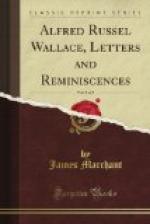ALFRED R. WALLACE.
* * * * *
HERBERT SPENCER TO A.R. WALLACE
57 Queen’s Gardens, Bayswater, W. December 5, 1867.
My dear Mr. Wallace,—I did not answer your last letter, being busy in getting out my second edition of “First Principles.”
I was quite aware of the alleged additional cause of flight which you name, and do not doubt that it is an aid. But I regard it simply as an aid. If you will move an outstretched wing backwards and forwards with equal velocity, I think you will find that the difference of resistance is nothing like commensurate with the difference in size between the muscles that raise the wings and the muscles that depress them. It seems to me quite out of the question that the principles of flight are fundamentally different in a bat and a bird, which they must be if the Duke of Argyll’s interpretation is correct. I write, however, not so much to reply to your argument as to correct a misapprehension which my expressions seem to have given you. The objections are not made by Tyndall or Huxley; but they are objections made by me, which I stated to them, and in which they agreed—Tyndall expressing the opinion that I ought to make them public. I name this because you may otherwise some day startle Tyndall or Huxley by speaking to them of their objections, and giving me as the authority for so affiliating them.—Very truly yours,
HERBERT SPENCER.
* * * * *
SIR C. LYELL TO A.R. WALLACE
73 Harley Street, London, W. November, 1867.
Dear Wallace,—You probably remember an article by Agassiz in an American periodical, the Christian Observer, on the diversity of human races, etc., to prove that each distinct race was originally created for each zoological and botanical province. But while he makes out a good case for the circumscription of the principal races to distinct provinces, he evades in a singular manner the community of the Red Indian race to North and South America. He takes pains to show that the same American race pervades North and South America, or at least all America south of the Arctic region. This was Dr. Morton’s opinion, and is, I suppose, not to be gainsaid. In other words, while the Papuan, Indo-Malayan, Negro and other races are strictly limited each of them to a particular region of mammalia, the Red Indian type is common to Sclater’s Neo-arctic and Neo-tropical regions. Have you ever considered the explanation of this fact on Darwinian principles? If there were not barbarous tribes like the Fuegians, one might imagine America to have been peopled when mankind was somewhat more advanced and more capable of diffusing itself over an entire continent. But I cannot well understand why isolation such as accompanies a very low state of social progress did




